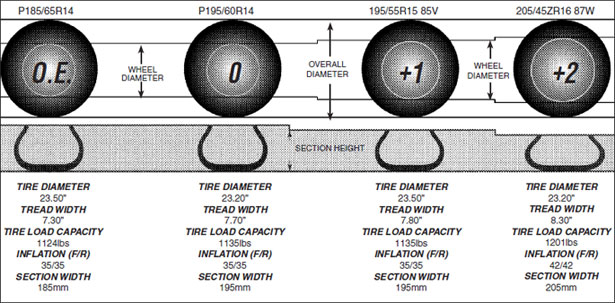Many enthusiasts like to install larger wheels & tires in order to improve the looks & performance of their vehicle. Indiscriminate installation of these parts however, can cause body & suspension clearance problems, speedometer error, ABS system interference and even tire failure. For these reasons, it is important that the original tire diameter & wheel offset be kept when changing wheels & tires. This is done by a process called Plus Sizing.
Plus Sizing can be +0, +1, +2, +3, etc. The advantage of Plus Sizing is that it puts more rubber in contact with the road. This improves a vehicle’s stability, traction, braking, handling & appearance. It should be noted however, that Plus sizing has some disadvantages. They include a harsher ride due to shorter, stiffer sidewalls; the possibility of wheel & tire damage due to pot holes; the potential of increased hydroplaning in wet conditions and the reduction in acceleration if unsprung weight is increased.

The rule of thumb for Plus Sizing is to add 10mm to a tire’s section width & reduce its aspect ratio by 10 points for every inch of increase in wheel diameter.
This is shown as follows:
| + 0 |
Increase the section width by 10 mm & reduce the aspect ratio by 5 points. Rim diameter remains the same in this case. Ex: A vehicle that came with an O.E. P185/65R14 tire, would now use a P195/60R14 tire. |
| + 1” |
Increase the section width by 10 mm & reduce the aspect ratio by 10 points. Rim diameter would increase of course by 1”. Ex: A vehicle that came with an O.E. P185/65R14 tire, would now use a P195/55R15 85V tire. |
| + 2” |
Increase the section width by 20 mm & reduce the aspect ratio by 20 points. Rim diameter would increase of course by 2”. Ex: A vehicle that came with an O.E. P185/65R14 tire, would now use a P205/45Z16 87W tire. |
| + 3” etc |
The Plus sizing formula does not always provide the best choice in extreme applications. As an example, take the Honda Civic that comes with an O.E. P175/70R13 size tire; If the rule were applied, you would add 30mm to the section width & reduce the aspect ratio by 30 points. The rim diameter would of course increase by 3”. This would mean a new size of 205/40R16. This tire however, has a load capacity of 853 lbs. at 36p.s.i., which is almost 200lbs less than the O.E. tire load rating of 1036lbs. This tire therefore, cannot be used. Fortunately Falken Tires offer an ZE512 - 205/40ZR16 83H that is reinforced and has a load rating of 1074 lbs. at 44p.s.i. As you can see, it is not only necessary that tire diameters be consistent but that load ratings be correct as well. |
| NOTES |
|
| 1. |
Do not increase tire diameter by more than 2% or decrease it by more than 3%. In the case of full size pickup trucks the tire diameter must not increase by more than 6% or decrease by more than 3%. This will prevent problems with the vehicle’s ABS system as well as eliminate speedometer & odometer errors. |
| 2. |
Although styles can be changed, the offset of the new wheel must not vary by more than 12mm (1/2”) in either direction from the original wheel specifications. |
| 3. |
Do not install wheels or tires that have a load capacity that is less than the manufacturer’s specifications. |
| 4. |
Do not use wheels that are too wide or too narrow for the tire being installed. Consult the tire manufacturer’s wheel size chart for the correct wheel width. |
| 5. |
Do not use an inflation pressure that is lower than the pressure recommended by the vehicle manufacturer. As a rule lower aspect ratio tires require higher tire pressures. Consult the tire manufacturer’s inflation guide for the correct tire pressure. |
| 6. |
Due to wheel and tire availability, as well as vehicle clearances, some plus sizing options may not be available. |
|
